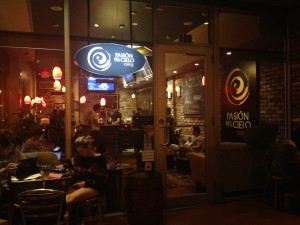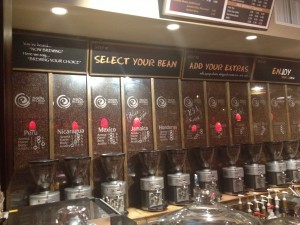Posted May 2, 2013
By ALEJANDRA GUTIERREZ
According to the legend, a young Arab in the 9th Century became very curious by the hyper behavior of his goats after eating certain grains from a tree. These grains became known as coffee: the second most consumed beverage in the world.
 Located in the City of Coral Gables, Pasión del Cielo is a coffee shop that brings the best coffee from Latin America and the Caribbean to the sunshine state.
Located in the City of Coral Gables, Pasión del Cielo is a coffee shop that brings the best coffee from Latin America and the Caribbean to the sunshine state.
With a variety of 11 pure coffee selections, you can decide which coffee you want to drink according to your palate. You may choose coffees from Brazil, Colombia, Cuba, Guatemala, Costa Rica, Honduras, Hawaii, Jamaica, Mexico, Nicaragua and Peru.
When you walk in, the staff treats you like a wine taster. They ask you if you want your coffee strong, medium, or soft; a simple question that may come as a surprise to many.
Coffee cultivation is only possible in the strip between the Tropic of Cancer and the Tropic of Capricorn: South America, Central America, Africa and Asia. The primary basis for the classification of coffee lies in the two most important and famous styles: Arabica and Robusta.
Coffea Arabica, or “mountain coffee” originally comes from Ethiopia. It’s a higher quality coffee with an intense flavor and great aroma, which contains half the caffeine in comparison to Robusta.
Coffea Robusta, on the other hand, comes from Zaire. It’s a coffee of lower quality and more caffeine than Arabica. The harvest is easier and can be grown on low ground, is more resistant to pests, and its production is much cheaper than Arabica.
Having a cup of coffee is almost a ritual every morning. However, people are not usually aware of the culture behind a simple cup. According to its cultivation, origin, flavor, aroma, texture, and treatment; cups of coffee vary. I chose to taste three brews form three completely different regions: Jamaica, Colombia and Nicaragua. It was a great experience that left me wanting to know more about coffee.
The sight is an important step for tasting. You have to be able to notice the tone and the grind of coffee. Roasting helps to better determine the distinctive characteristics of the drink. If coffee is finely ground, bitter and sour flavors become noticeable.
With the smell you can identify whether the coffee has herbal or floral notes. After adding hot water, you can see how the aroma changes or remains the same. While preparing the infusion, you can identify the deeper notes of the coffee bean.
Then the most exciting part begins, tasting. After pouring your cup of coffee, you begin the tasting by taking small sips to discover its true flavor. Sweetness is perceived on the tip of the tongue. Sugars are very subtle and delicate. Acid causes salivation on the sides of the tongue. It can be low, medium or high, but it is always pleasant. Bitter is seen at the end of the tongue. It is a characteristic of intense coffee flavor and the feeling persists after trying it. The body depends on the amount of soluble solids in suspension. This is the texture of coffee.
 Originally from the Blue Mountains, my first cup of coffee was an Arabica coffee from Jamaica. It had a delicate and perfect balance in terms of acidity and body with an intense aroma.
Originally from the Blue Mountains, my first cup of coffee was an Arabica coffee from Jamaica. It had a delicate and perfect balance in terms of acidity and body with an intense aroma.
This coffee was soft, with medium acidity, and it didn’t have a strong aftertaste. It had a fruity flavor to it and low caffeine content.
I then started the same procedure all over again, but now I was about to have a cup of coffee from the mountains of Colombia. This coffee is 100% Arabica. The first thing I noticed as I took my first sip was the softness of it. It had a strong aroma, in comparison to the Jamaican coffee, that I was able to perceive immediately after pouring the hot water to the cup of coffee beans. It had a good acidity and exquisite taste, with a nice aftertaste.
I then waited for about half and hour to try the next cup. Not because the service was slow, but because I truly wanted to enjoy this place. I was captivated by its ambience. It was amicable, small yet comfortable, and it had a good cultural sense to it. I could hear people talking about interesting things such as theater and art, others reading books, while some where laughing and just having a fun time in company of a good cup of coffee.
Then the third cup of coffee came. This time, I tried some coffee from Nicaragua. I got my eyes, nose and mouth and ready; and I was ready to begin. I first noticed it was a very fragrant coffee; but not as much as the cup of Colombian cup. However, it had a sweet flavor that I liked a lot. It was very creamy with a medium acid. It almost tasted like chocolate. The aftertaste was durable and sweet.
My fourth and last cup of coffee was from, of course, Brazil. This was a coffee that lingered in my mouth. It was smooth with low acidity, creamy and fruity. However, the smell of it was not as strong as the Colombian coffee. Brazil is the first producer of coffee in the world,
After trying all three coffees and taking into consideration all the characteristics that made each cup of coffee particular; in my opinion, the best cup of coffee was the brew from Colombia. I would definitely recommend all three coffees because they had a very high quality; however, there is no question why Colombia’s coffee is considered the best in the world.
The taste is deep and rich, yet light and delicate with an exceptional aroma. Overall, it had a mild flavor, pleasant aroma and balanced content-that is, not too bitter, not too acidic. There are not enough superlatives to define this exquisite coffee. It is very close to perfection, both in appearance and in taste.
If you want a good cup of coffee, try Colombia’s best coffee. Sit back, relax and enjoy. I can guarantee that you will want another cup.
Besides the coffees just mentioned, there is a variety of high-quality coffee all over the world; each from a completely different region, climate and territory.
Vietnam coffee, for example, has been placed on the international coffee map. It was the second largest exporter of coffee in the world in 2011. The coffee grown in this Asian country is mainly Robusta. The Vietnamese coffee product is characterized for its density, bitterness and acidity. It is mainly exported to the United States, Germany and Spain.
In the last years, India became a coffee country not only in production but also in consumption. Figures from the International Coffee Organization placed this country as the fourth largest exporter of coffee in the 2011 cycle. Their crops are mainly Arabic, with a dense body, delicate acidity and light aroma.
Peru has become a great competitor in the world of coffee. it is an Arabic type, characterized by having a caramel flavor and soft aroma with light body. Peruvian beans have a high demand internationally. They are very popular in United States, Canada, Germany, the United Kingdom, Germany, Japan, Norway, the Netherlands and Switzerland. Be in the look out for their growing product.
Although there are many myths that talk about the risks of drinking coffee, several studies have shown that moderate consumption of coffee can be beneficial to the health of people.
The latest study on the properties of caffeine, published in the December issue of the prestigious American Journal of Clinical Nutrition, concluded that coffee reduces the risk of type 2-diabetes. For men the chances of contracting this disease diminished between a four and a seven percent, and for women eight percent. It also reduces the risk of heart failure, colon cancer; just to name a few.
 So how you can make a good cup of coffee at home? Although must people do not know this, coffee has its science.
So how you can make a good cup of coffee at home? Although must people do not know this, coffee has its science.
A deep clean of your coffeemaker will remove all coffee grounds and other impurities, which can affect the taste of coffee. Make a mixture of water and vinegar, or baking soda, and allow it to flow during the normal cycle. Once your cycle is done, you can start to make your own good cup of coffee.
The fresher the coffee beans, the better tasting it will have. I recommend that you buy fresh beans. The green beans can last up to a year, if you keep them cool and dry. When you buy your coffee make sure it is browned and grounded.
Water temperature is probably the most important characteristic of making a good cup of coffee. The water should have a temperature between 190 and 200 degrees. Many coffee makers fail to heat the water at this temperature; if your coffeemaker produces a sour taste, boil water and add it to your coffeemaker.
On the other hand, if your coffee develops a strong flavor, is better that you add 1/4 cup of cold water. It is best to use bottled or filtered water. Some people prefer to use distilled or deionized water. Now you can enjoy a good cup of coffee at the comfort of your own home!
